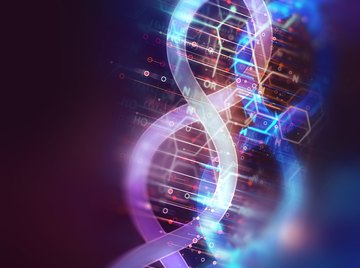
The two-stranded, double helix-shaped molecule deoxyribonucleic acid (DNA) stores the genetic code for most organisms. DNA not only contains genetic instructions for cell division and reproduction, but it also functions as the basis for thousands of proteins. This entails two processes: transcription and translation.
TL;DR (Too Long; Didn't Read)
For protein synthesis, messenger RNA must be made from one strand of DNA called the template strand. The other strand, called the coding strand, matches the messenger RNA in sequence except for its use of uracil in place of thymine.
Transcription
For protein synthesis, DNA must first be copied to messenger ribonucleic acid, or mRNA. This process is called transcription. The mRNA holds the coding information to make proteins. Unlike DNA, RNA is single-stranded and not helical in shape. It contains ribose instead of deoxyribose, and its nucleotide bases differ by having uracil (U) instead of thymine (T).
Initially, the enzyme RNA polymerase must assemble the pre-mRNA molecule that complements a section of one DNA’s two strands. Since the goal is not replication but protein synthesis, only one strand of DNA needs copying. The RNA polymerase first attaches to the double helix of DNA and works with proteins called transcription factors to determine what information needs transcribing. The RNA polymerase and transcription factors bind to this DNA strand, called the template strand.
The unit of RNA polymerase and transcription factors moves along the strand in a 3’ to 5’ (3 prime to 5 prime) direction and makes a new strand of mRNA with complementary base pairs. RNA polymerase builds the mRNA with additional nucleotides in elongation. The complementary nucleotides in mRNA, however, differ from DNA in that uracil replaces thymine. The mRNA runs in a 5’ to 3’ (5 prime to 3 prime) direction. After elongation ceases, mRNA separates from the DNA template strand in termination. Then mRNA serves either in a role of messenger in the cell, or it is used in protein formation, or translation.
Translation
The newly assembled mRNA can begin translation. Translation entails reading the mRNA to generate new proteins. Codons, sequences in combinations of three of the mRNA nucleotides A, C, G or U make up amino acids. Ribosomes, cells’ protein-making units, work to build new proteins from chains of those amino acids.
Template Strand
The DNA strand that mRNA is built from is called the template strand because it serves as a template for transcription. It is also called the antisense strand. The template strand runs in a 3’ to 5’ direction.
Coding Strand
The strand of DNA not used as a template for transcription is called the coding strand, because it corresponds to the same sequence as the mRNA that will contain the codon sequences necessary to build proteins. The only difference between the coding strand and the new mRNA strand is instead of thymine, uracil takes its place in the mRNA strand. The coding strand is also called the sense strand. The coding strand runs in a 5’ to 3’ direction.
The dual processes of transcription and translation could not proceed without the double-stranded nature of the DNA double helix.
References
About the Author
J. Dianne Dotson is a science writer with a degree in zoology/ecology and evolutionary biology. She spent nine years working in laboratory and clinical research. A lifelong writer, Dianne is also a content manager and science fiction and fantasy novelist. Dianne features science as well as writing topics on her website, jdiannedotson.com.
